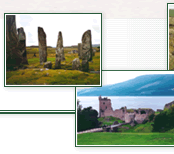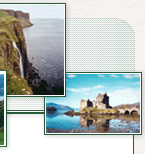 The United Kingdom (UK) constitutes the greater part of the British Isles. The largest part of the islands is Great Britain which comprises England, Scotland and Wales. The next largest is Ireland, comprising Northern Ireland, which is part of the UK, and the Irish Republic.
The United Kingdom (UK) constitutes the greater part of the British Isles. The largest part of the islands is Great Britain which comprises England, Scotland and Wales. The next largest is Ireland, comprising Northern Ireland, which is part of the UK, and the Irish Republic.
If you look at a map of the British Isles, you will see that Ireland and Scotland are only a short distance apart, as little as 12 miles at one point. While both countries have much in common, each is unique in temperament, landscape, and charm. Two of the original seven Celtic nations, Scotland and Ireland have survived centuries of economic and political adversity to become lands filled with history, culture, mystery, and beauty.
Scotland
The country of Scotland is approximately the size of the state of Maine. Western Scotland is fringed by the large chain of islands known as the Inner and Outer Hebrides (pronounced 'heb-rid-deeze'). Off the north coast are the Orkney and Shetland Islands.
With a population of more than five million in a land area greater than 30,000 square miles (48,955 including the islands), much of Scotland is rural. It is divided into three distinct areas: the mountainous Highlands and Islands in the north, the softly flat lowlands in the center, and the hilly uplands in the south, bordering England and referred to as the Borders.
 Scotland emerged as a nation in the middle of the ninth century as Scotia. The King of the Scots, Kenneth Macalpine, achieved a union between the ancient Picts and the Scots -- Irish Celts (pronounced 'kelts') known as Scotti -- and it remained an independent country until 1707, when economics and politics forced the Treaty of Union with England.
Scotland emerged as a nation in the middle of the ninth century as Scotia. The King of the Scots, Kenneth Macalpine, achieved a union between the ancient Picts and the Scots -- Irish Celts (pronounced 'kelts') known as Scotti -- and it remained an independent country until 1707, when economics and politics forced the Treaty of Union with England.
Scotland has 790 islands on its perimeter, with 25 percent of them being inhabited. You are never more than 40 miles from the sea -- even on the mainland. Situated between 55 and 60 degrees north, Scotland enjoys long daylight hours in summertime.
The weather varies and there is a saying in Scotland that, if you don't like the weather then wait a few minutes and it will change! In actuality, Rome receives more rainfall than Scotland's capital city of Edinburgh (pronounced 'Ed-in-burra'). Spring and Fall are cool and sunny, early Summer is traditionally the rainy season, and July and August are the warmest months. As we all know, there is no way to predict the weather. In 2003 the Highlands had a long hot spell with 90F+ degree temperatures, virtually unheard of in Scotland. The temperature seldom goes below 30F degrees on the mainland because the air is warmed by the currents of the Gulf Stream.
Famous Scots include Alexander Graham Bell, Robert Burns, Andrew Carnegie, Sean Connery, JK Rowling, Sir Walter Scott, Robert Louis Stevenson, and William Wallace.
Ireland
Ireland is an island slightly larger than the state of South Carolina. Covering more than 32,000 square miles, it is 300 miles long and 190 miles wide. Regionally, it is divided into the four provinces of Ulster in the north, Munster in the south, Leinster in the east, and Connacht in the northwest.
 The population is currently 5.6 million, with more than half of the people being under the age of 30. Maybe this relates to the fact that Ireland is currently the world's leading exporter of software!
The population is currently 5.6 million, with more than half of the people being under the age of 30. Maybe this relates to the fact that Ireland is currently the world's leading exporter of software!
Ireland has a rich heritage and many ancient remnants remain, among them being 5000-year-old tombs, Celtic (pronounced 'keltic') forts from the Bronze and Iron Ages, and the mysterious prehistoric megaliths. The earliest settlements are traced to 7000 BC. Around the end of the first millenium BC, the Celts, an Indo-European people, arrived and created a powerful presence, controlling the country for 1000 years. Their language and culture survive today. After a few centuries of Viking invasions (8th century) and settlements (9th century), the English arrived with the Normans (12th century) and thus began the shaping of the country as we know it today. The south of Ireland became a republic in 1948, while the north of Ireland remains part of the United Kingdom.
Ireland has a mild temperate climate and the temperature seldom is below 40F degrees because of the warm currents of the Gulf Stream. Snow is rare but showers can happen anytime -- and so can rainbows!










